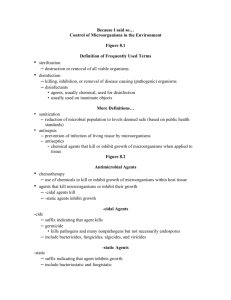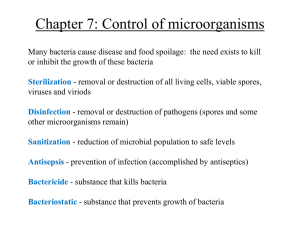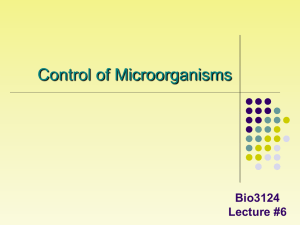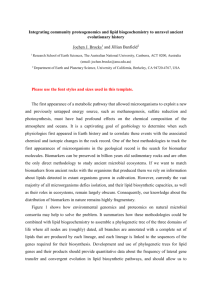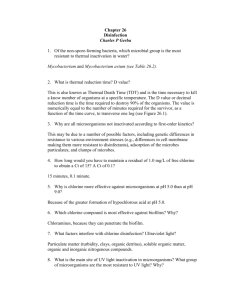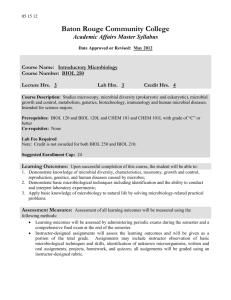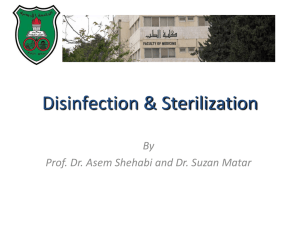chapter objectives
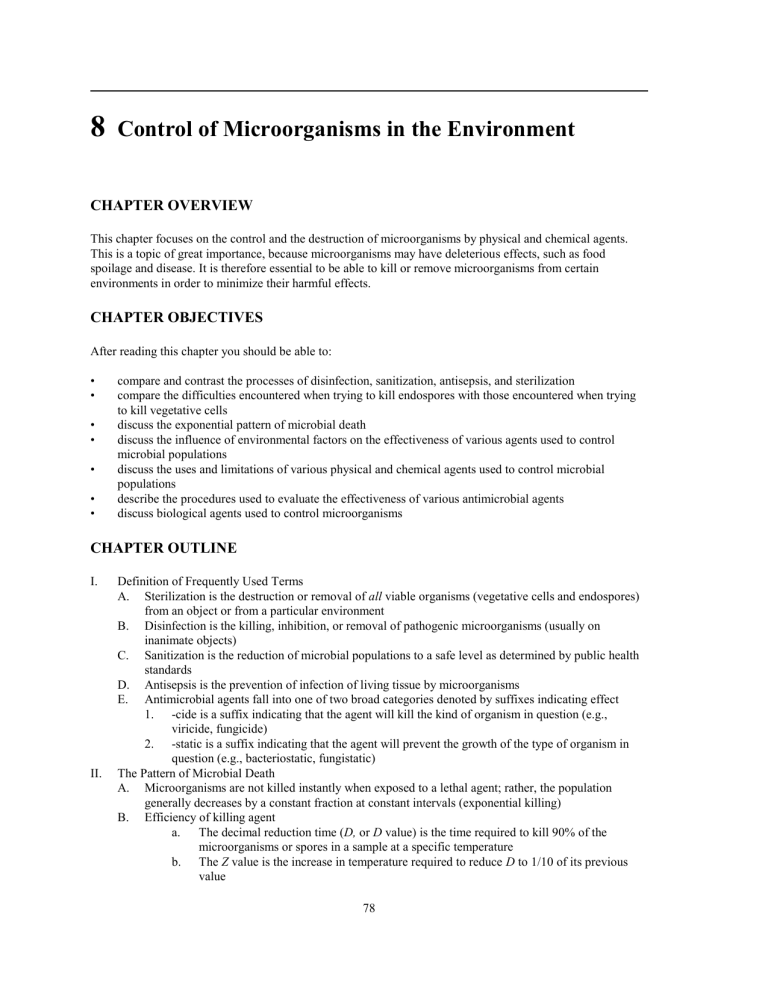
8
Control of Microorganisms in the Environment
CHAPTER OVERVIEW
This chapter focuses on the control and the destruction of microorganisms by physical and chemical agents.
This is a topic of great importance, because microorganisms may have deleterious effects, such as food spoilage and disease. It is therefore essential to be able to kill or remove microorganisms from certain environments in order to minimize their harmful effects.
CHAPTER OBJECTIVES
After reading this chapter you should be able to:
• compare and contrast the processes of disinfection, sanitization, antisepsis, and sterilization
• compare the difficulties encountered when trying to kill endospores with those encountered when trying to kill vegetative cells
• discuss the exponential pattern of microbial death
• discuss the influence of environmental factors on the effectiveness of various agents used to control microbial populations
• discuss the uses and limitations of various physical and chemical agents used to control microbial populations
• describe the procedures used to evaluate the effectiveness of various antimicrobial agents
• discuss biological agents used to control microorganisms
CHAPTER OUTLINE
I.
Definition of Frequently Used Terms
A.
Sterilization is the destruction or removal of all viable organisms (vegetative cells and endospores) from an object or from a particular environment
B.
Disinfection is the killing, inhibition, or removal of pathogenic microorganisms (usually on inanimate objects)
C.
Sanitization is the reduction of microbial populations to a safe level as determined by public health standards
D.
Antisepsis is the prevention of infection of living tissue by microorganisms
E.
Antimicrobial agents fall into one of two broad categories denoted by suffixes indicating effect
1.
-cide is a suffix indicating that the agent will kill the kind of organism in question (e.g., viricide, fungicide)
2.
-static is a suffix indicating that the agent will prevent the growth of the type of organism in question (e.g., bacteriostatic, fungistatic)
II.
The Pattern of Microbial Death
A.
Microorganisms are not killed instantly when exposed to a lethal agent; rather, the population generally decreases by a constant fraction at constant intervals (exponential killing)
B.
Efficiency of killing agent a.
The decimal reduction time ( D, or D value) is the time required to kill 90% of the microorganisms or spores in a sample at a specific temperature b.
The Z value is the increase in temperature required to reduce D to 1/10 of its previous value
78
C.
A microorganism is usually considered dead when it is unable to grow in conditions that would normally support its growth and reproduction; however, the issue is confounded by organisms that are in a viable but nonculturable (VBNC) state
III.
Conditions Influencing the Effectiveness of Antimicrobial Agents
A.
Population size—larger populations take longer to kill than smaller populations
B.
Population composition—populations consisting of different species or of cells at different developmental stages (e.g., endospores versus vegetative cells or young cells versus old cells) differ markedly in their sensitivity to various agents
C.
Concentration or intensity of the antimicrobial agent—higher concentrations or intensities are generally more efficient, but the relationship is not linear
D.
Contact time—the longer the exposure, the greater the number of organisms killed
E.
Temperature—a higher temperature will usually (but not always) increase the effectiveness of killing
F.
Local environment—environmental factors (e.g., pH, viscosity, and concentration of organic matter) can profoundly influence the effectiveness of a particular antimicrobial agent
IV.
Physical Control Methods
A.
Heat
1.
Killing with moist heat a.
Boiling water is effective against vegetative cells and eukaryotic spores, but not bacterial spores b.
Autoclaving (steam under pressure) at 121
C is effective against most vegetative cells and bacterial endospores c.
Pasteurization, a process involving brief exposure to temperatures below the boiling point of water, reduces the total microbial population and thereby increases the shelf life of the treated material; it is often used for heat-sensitive materials that cannot withstand prolonged exposure to high temperatures d.
Tyndallization uses exposures to steam to kill vegetative cells; spores are allowed to grow and then the steam treatment is repeated; after several cycles the material is sterilized
2.
Dry heat can be used to sterilize moisture-sensitive materials such as powders, oils, and similar items; it is less efficient than moist heat and usually requires higher temperatures (160 to
170
C) and longer exposure times (2 to 3 hrs)
B.
Filtration sterilizes heat-sensitive liquids and gases by removing microorganisms rather than destroying them
1.
Depth filters are thick fibrous or granular filters that remove microorganisms by physical screening, entrapment, and/or adsorption
2.
Membrane filters are thin filters with defined pore sizes that remove microorganisms, primarily by physical screening
3.
Air can be sterilized by passage through surgical masks, cotton plugs in culture vessels, and high-efficiency particulate air (HEPA) filters; HEPA filters are used in laminar flow biological safety cabinets to sterilize the air circulating in the enclosure
C.
Radiation
1.
Ultraviolet (UV) radiation is effective, but its use is limited to surface sterilization because UV radiation does not penetrate glass, dirt films, water, and other substances
2.
Ionizing radiation (gamma radiation) is effective and penetrates the material
V.
Chemical Control Agents
A.
Phenolics—laboratory and hospital disinfectants; act by denaturing proteins and disrupting cell membranes; widely used agents include Lysol and triclosan
B.
Alcohols—widely used disinfectants and antiseptics; will not kill endospores; ethanol and isopropanol are most widely used
C.
Halogens—widely used antiseptics and disinfectants; iodine acts by oxidizing cell constituents and iodinating cell proteins; chlorine acts primarily by oxidizing cell constituents
D.
Heavy metals—effective but usually toxic; act by combining with proteins and inactivating them
79
E.
Quaternary ammonium compounds—cationic detergents used as disinfectants for food utensils and small instruments, and because of low toxicity, as antiseptics for skin; act by disrupting biological membranes and possibly by denaturing proteins; benzalkonium chloride and cetylpyridinium chloride are widely used
F.
Aldehydes—reactive molecules that can be used as chemical sterilants; may irritate the skin; act by combining with nucleic acids and proteins and inactivating them; formaldehyde and glutaraldehyde are widely used
G.
Sterilizing gases (e.g., ethylene oxide, betapropiolactone)—can be used to sterilize heat-sensitive materials such as plastic culture dishes and disposable syringes; act by combining with proteins and inactivating them; vaporized hydrogen peroxide has been used to decontaminate large facilities
VI.
Evaluation of Antimicrobial Agent Effectiveness
A.
The phenol coefficient test is a useful initial screening test in which the potency of a disinfectant is compared to that of phenol
B.
A more realistic test is the use dilution test; in this test, stainless steel cylinders are contaminated with specific bacterial species under carefully controlled conditions and then exposed to the disinfectant
VII.
Biological Control of Microorganisms
A.
An emerging group of control agents rely on one microbe to kill another; processes include predation, viral-mediated lysis, and toxin-mediated killing
TERMS AND DEFINITIONS
Place the letter of each term in the space next to the definition or description that best matches it.
____ 1. Destruction or removal of all viable microorganisms from an object or a particular environment
____ 2. An antimicrobial agent that kills algae
____ 3. The killing, inhibition, or removal of microorganisms that may cause disease
____ 4. Agents used to carry out disinfection of inanimate objects
____ 5. Reduction of the microbial population to safe levels as determined by public health standards
____ 6. The prevention of infection by controlling microorganisms on living tissue
____ 7. Chemical agents applied to living tissue to prevent infection
____ 8. A chemical or physical agent that inactivates microorganisms
____ 9. A process that sterilizes by using repeating cycles of steam and incubation
____ 10. The time required to kill 90% of the microorganisms or spores in a sample at a specific temperature
____ 11. The increase in temperature required to reduce D to
1/10 its value a. algicide b. antisepsis c. antiseptics d. bactericide e. bacteriostatic f. biocide g. decimal reduction time ( D ) h. detergents i. disinfectant j. disinfection k. F value l. fungistatic m. germicide n. pasteurization o. phenol coefficient test p. sanitization q. sterilization r. tyndallization s. viricide t. Z value
80
____ 12. The process in which a microbial population is reduced by raising the temperature of heat-sensitive materials to something less than the boiling point of water for relatively short periods of time
____ 13. An antimicrobial agent that inhibits the growth of fungi
____ 14. Organic molecules that serve as wetting agents and emulsifiers because they have both polar hydrophilic ends and nonpolar hydrophobic ends; such molecules that are cationic are useful as disinfectants
____ 15. A test that measures the efficiency of a disinfectant by comparing it to phenol
____ 16. An antimicrobial agent that kills bacteria
____ 17. An antimicrobial agent that inhibits the growth of bacteria
____ 18. An antimicrobial agent that kills pathogens (and many nonpathogens but not necessarily endospores)
____ 19. An antimicrobial agent that destroys viruses
FILL IN THE BLANK
1. A
2.
will not necessarily sterilize an object because viable spores may still remain.
heat is thought to kill effectively by degrading nucleic acids, denaturing proteins, and disrupting cell membranes.
3. Pasteurization of milk involves heating it to 63
C for 30 minutes or to 72°C for 15 seconds. The latter protocol is called pasteurization. Pasteurization procedures do not ____________ milk but do kill ____________ and reduce the total microbial population in milk, thereby drastically slowing spoilage and increasing shelf life. Some milk products (e.g., individual serving coffee creamers) are made by heating milk to 140 to 150°C for 1 to 3 seconds. This process is called sterilization.
4. Gamma radiation, a type of radiation has been used to pasteurize meats, fish, and other foods. However, this process has not been widely employed because of expense and because of concerns
5. about the long-term effects on the irradiated foods.
are germicidal because they denature proteins and disrupt cell membranes. However, their use is limited because they have a disagreeable odor and may cause irritation of the skin.
6. The two most popular germicides are ethanol and isopropanol.
7. Iodine is an effective antiseptic that kills by cell constituents. However, there are some problems associated with its use. Recently, iodine has been complexed with an organic carrier to form an
____________. This preparation is water soluble, stable, and nonstaining, and releases ____________ slowly, thus minimizing skin burns and irritation.
8. ____________ is the disinfectant of choice for municipal water supplies and swimming pools, and is also employed in the dairy and food industries. Campers frequently use it in the form of halazone tablets to purify small volumes of drinking water.
9. Heavy metals are effective antimicrobial agents, but they are often toxic. Therefore, only a few are regularly used. For instance, is applied to the eyes of infants to prevent ophthalmic gonorrhea, and is used as an algicide in lakes and swimming pools.
10. compounds such as benzalkonium chloride kill most bacteria, but do not kill
Mycobacterium tuberculosis or spores. They have the advantage of being stable, nontoxic, and bland, but they are inactivated by hard water and soaps.
11. The two commonly used are formaldehyde and glutaraldehyde. They are highly reactive and are ____________ and can therefore be used as chemical sterilants.
12. Treatment with boiling water kills vegetative forms, but must be used to destroy endospores. These instruments heat materials in a chamber that reaches °C and of pressure.
13. One of the most important air filtration systems is used in safety cabinets.
pounds
filters, which are often
81
14. In the test, stainless steel cylinders are contaminated with specific bacterial species under controlled conditions. After being briefly dried, the cylinders are immersed in the being tested for 10 minutes, transferred to culture media, and incubated for 2 days.
MULTIPLE CHOICE
For each of the questions below select the one best answer.
1. Which of the following is NOT a reason for studying methods of destroying microorganisms? a. It makes microbial research possible. b. preservation of food c. prevention of disease a. b. c. concentration of the agent duration of exposure to the agent temperature d. All of the above contribute.
7. Which of the following is normally used to remove microorganisms from air? d. All of the above are reasons for studying methods of destroying microorganisms.
2. What is an agent that specifically kills fungi but not other kinds of microorganisms? a. germicide a. b. c. depth filters membrane filters
HEPA filters d. None of the above is correct.
8. Which of the following is usually used to define microbial death?
3. b. c. d. a. fungicide germistatic agent fungistatic agent
Which will require a longer time to kill? a large population of microorganisms b. a small population of microorganisms c. Neither; killing will be equally rapid in either a large or a small microbial population. d. There is no way to predict which will require a longer time to kill.
4. Which of the following may contribute to resistance to killing? a. formation/existence of endospores a. The organism will not grow on minimal medium. b. The organism will not grow on a medium that normally supports its growth. c. The organism no longer retains its original shape and structures. d. None of the above adequately define microbial death.
9. The process of heating milk products to 72
C b. c. d. increased age of the culture inherent/genetic differences among organisms
All of the above may contribute to resistance to killing.
5. Which of the following is NOT a method by which depth filters normally sterilize materials passing through them? a. exclusion of materials too large to penetrate the filter b. entrapment of material in the channels of the filter c. destruction of cells by interaction with the filter’s harmful chemical composition d. adsorption of cells to the surface of the filter material
6. Which of the following contributes to the effectiveness of a disinfectant or sterilizing agent? for 15 seconds in order to reduce the microbial population is called ____________ pasteurization. a. flash b. fast c. ultrafast d. None of the above is correct.
10. Which of the following is a property of an ideal disinfectant? a. effective against a wide variety of infectious agents b. nontoxic to people c. noncorrosive for common materials d. All of the above are properties of an ideal disinfectant.
82
TRUE/FALSE
____ 1. In sanitization, the inanimate object is usually cleaned as well as partially disinfected.
____ 2. Antiseptics are generally not as toxic as disinfectants.
____ 3. Although many agents kill or control the growth of nonpathogenic organisms as well as pathogenic organisms, only their effects on pathogens are important in evaluating their usefulness.
____ 4. Although agents normally kill a constant fraction of the microbial population in a constant period of time, the rate of killing may decrease when the population has been greatly reduced. One reason for this may be the survival of a resistant strain of the organism.
____ 5. Dry heat sterilization is generally faster than moist heat sterilization.
____ 6. Since filtration removes rather than destroys microorganisms, it does not truly sterilize the materials passing through the filter.
____ 7. Ultraviolet radiation is normally used to sterilize air and exposed surfaces, but it cannot be used to sterilize interior compartments because it does not penetrate into those compartments.
____ 8. Only anionic detergents are useful as disinfectants.
____ 9. Ethylene oxide is used to sterilize heat-sensitive materials such as plastic culture dishes, and it is particularly effective because it can penetrate even the plastic wrap used to package these plates.
Therefore, they can be sealed before sterilization, and the chance of contamination after treatment can be eliminated.
____ 10. The phenol coefficient is a direct indication of disinfectant potency during normal use.
____ 11. Death of microorganisms is defined as the loss of the ability to grow on a medium that would normally support growth.
____ 12. A sterile object is completely free of viable microorganisms.
____ 13. Most chemical agents are effective sterilants.
____ 14. Membrane filters are porous membranes made of cellulose acetate or other synthetic materials. They are used to remove most vegetative cells, but not viruses, from liquids.
CRITICAL THINKING
1. Pasteurization can take place by either of two methods. In one a lower temperature is used for a longer period of time, while in the other a higher temperature is used for a shorter period of time. Which method is more advantageous and why?
2. Consider the various chemicals that can be used as disinfectants and antiseptics. What criteria would you use to select the right chemical for a particular task? Give at least two specific examples of situations.
Then give your selection for each situation and defend your choice.
83
3. Biological control of microorganisms uses the natural killing abilities of bacteria and viruses to control pathogens. In some cases, viruses are used as the treatment agent. Why do you think that there might be resistance to this kind of treatment by the general public? Do you think that these concerns have some validity? Explain your opinions by giving reasons why there may be concern and how researchers can reduce these concerns.
ANSWER KEY
Terms and Definitions
1. q, 2. a, 3. j, 4. i, 5. p, 6. b, 7. c, 8. f, 9. r, 10. g, 11. t, 12. n, 13. l, 14. h, 15. o, 16. d, 17. e, 18. m,
19. s
Fill in the Blank
1. disinfectant 2. Moist 3. flash; sterilize; pathogens; ultrahigh-temperature 4. ionizing 5. Phenolics
6. alcohol 7. oxidizing; iodophore; iodine 8. Chlorine 9. silver nitrate; copper sulfate 10. Quaternary ammonium 11. aldehydes; sporicidal 12. autoclaves; 121; 15 13. high-efficiency particulate air; laminar flow biological 14. use dilution; disinfectants
Multiple Choice
1. d, 2. b, 3. a, 4. d, 5. c, 6. d, 7. c, 8. b, 9. a, 10. d
True/False
1. T, 2. T, 3. F, 4. T, 5. F, 6. F, 7. T, 8. F, 9. T, 10. F, 11. T, 12. T, 13. F, 14. T
84
